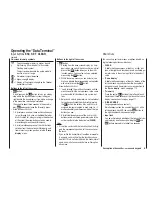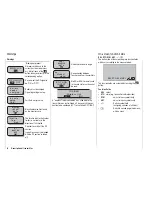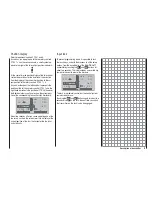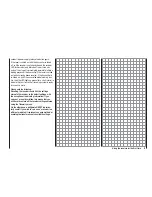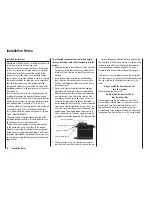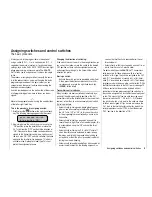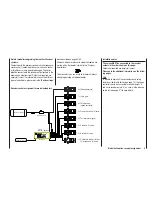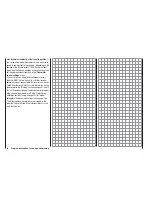
35
Installation Notes
Receiving system power supply
A reliable power supply is one of the basic essentials for
reliable model control. Free-moving pushrods, a fully-
charged battery, battery connecting leads of adequate
cross-section, minimal transfer resistance at the connec-
tors etc. all help to minimise energy consumption, but
if you have attended to all this, and the receiver volt-
age displayed on the transmitter screen still collapses
repeatedly, or is generally (too) low, then please note the
following:
The fi rst point to check is that your batteries are always
fully charged at the start of each fl ying session. Check
that contacts and switches are low in resistance. It is a
good idea to measure the voltage drop over the installed
switch harness under load, as even a new, heavy-duty
switch can cause a voltage drop of up to 0.2 Volt. Ageing
effects and oxidation of the contacts can increase this
several times over. Constant vibration and movement
at the contacts also “gnaws away” at the contacts, and
tends to produce a creeping increase in transfer resist-
ance.
It is also true that even small servos, such as the
Graup-
ner/JR
DS-281, can draw currents of up to 0.75 Ampere
when stalled (mechanically obstructed). Just four servos
of this type in a “foamy” can therefore place a load of up
to 3 Amps on the airborne power supply ...
For this reason you should always choose a receiver
battery which constantly delivers an adequate voltage,
i. e. which does not collapse under severe load. To “cal-
culate” the necessary battery capacity we recommend
as a starting point that you provide 350 mAh for each
analogue servo, and at least 500 mAh for each digital
servo.
For example, a 1400 mAh battery would represent an
absolute minimum as the power supply for a receiving
system with a total of four analogue servos. When mak-
ing your calculations, however, please bear the receiver
in mind as well, as it draws a current of around 70 mA
due to its bi-directional function.
Regardless of these considerations, it is generally advis-
able to connect the power supply to the receiver using
two leads: lead “1” is connected to the 6+B receiver
socket in the usual way, and lead “2” to the opposite
socket, marked 1+B, at the other end of the receiver
socket bank. For example, you could use a switch or
voltage regulator with two power supply leads running
to the receiver. You might install a Y-lead, Order No.
3936.11
, between lead and receiver, as shown in the
diagram below, if you wish to use one or both of the
receiver sockets to connect a servo, speed controller,
etc. The dual connection at the switch or voltage regu-
lator not only reduces the risk of a cable fracture, but
also ensures a more even energy supply to the servos
connected to the receiver.
Auxiliary function
Y-lead,
Order No.
3936.11
PRX stabilised
receiver power supply,
Order No.
4136
Four-cell Ni-MH battery packs
Traditional four-cell packs are a good choice for power-
ing your
Graupner
HoTT receiving system, provided that
you observe the conditions described above, i. e. you
must ensure that the packs have adequate capacity and
maintain their voltage well.
Five-cell NiMH battery packs
Five-cell batteries offer a wider margin of safety in terms
of voltage compared with four-cell packs. However,
please note that not all servos available on the market
can tolerate the voltage of a fi ve-cell pack (in the long-
term), especially when the battery is freshly charged.
For example, many of these servos respond to the high
voltage with a clearly audible “rumble”.
It is therefore important to check the specifi cation of the
servos you intend to use before you make the decision
to use fi ve-cell packs.
Two-cell Nanophosphate® (A123) batteries
Taking into account the current situation, these new cells
are now regarded as the optimum choice for receiver
packs. A123 cells can be fast-charged in conjunction
with a suitable battery charger, and are protected by a
metal case and therefore comparatively robust. It is also
true that a much higher number of charge / discharge
cycles is attributed to this cell type than, for example,
to LiPo cells. The nominal voltage of 6.6 Volt of a two-
cell Nanophosphate® pack presents no problems to
Graupner
HoTT receivers, nor to those servos, speed
controllers, gyros, etc. which are expressly approved for
use at these higher voltages.
Please note, however,
that virtually all servos, speed controllers, gyros etc.
sold in the past, and also most of those currently
available, are only approved for use on an operating
voltage in the range 4.8 to 6 Volt.
If you wish to con-
nect these devices to the receiver, it is essential to use
a stabilised regulated power supply, such as the PRX,
Order No.
4136
; see Appendix. If you neglect this, there
is a danger that the connected devices will quickly suffer
permanent damage
Two-cell LiPo battery packs
For a given capacity LiPo batteries are a great deal
lighter than the battery types described above, but they
Summary of Contents for mx-16 HOTT
Page 7: ...7 For your notes...
Page 37: ...37 For your notes...
Page 41: ...41 For your notes...
Page 45: ...45 For your notes...
Page 51: ...51 For your notes...
Page 55: ...55 For your notes...
Page 81: ...81 For your notes...
Page 103: ...103 For your notes...
Page 133: ...133 For your notes...
Page 141: ...141 For your notes...
Page 161: ...161 For your notes...
Page 173: ...173 For your notes...





